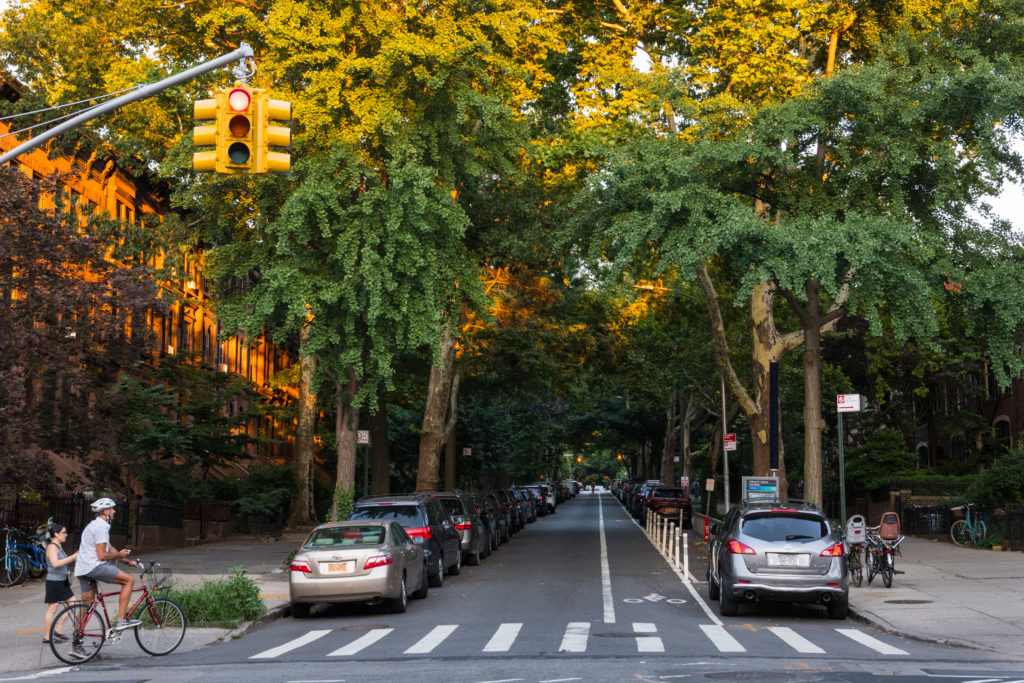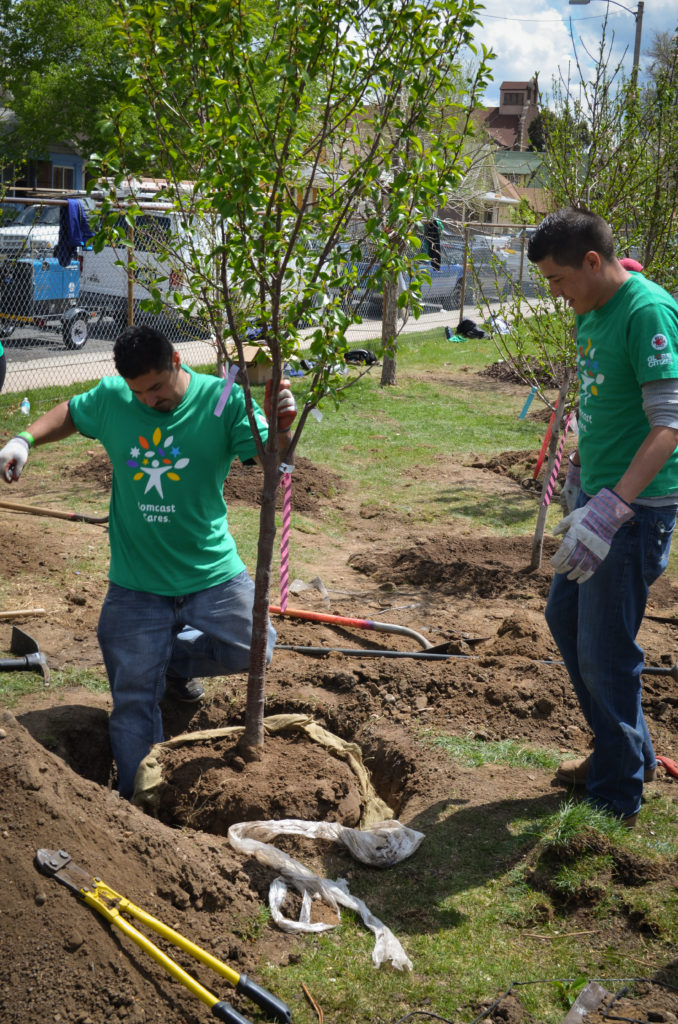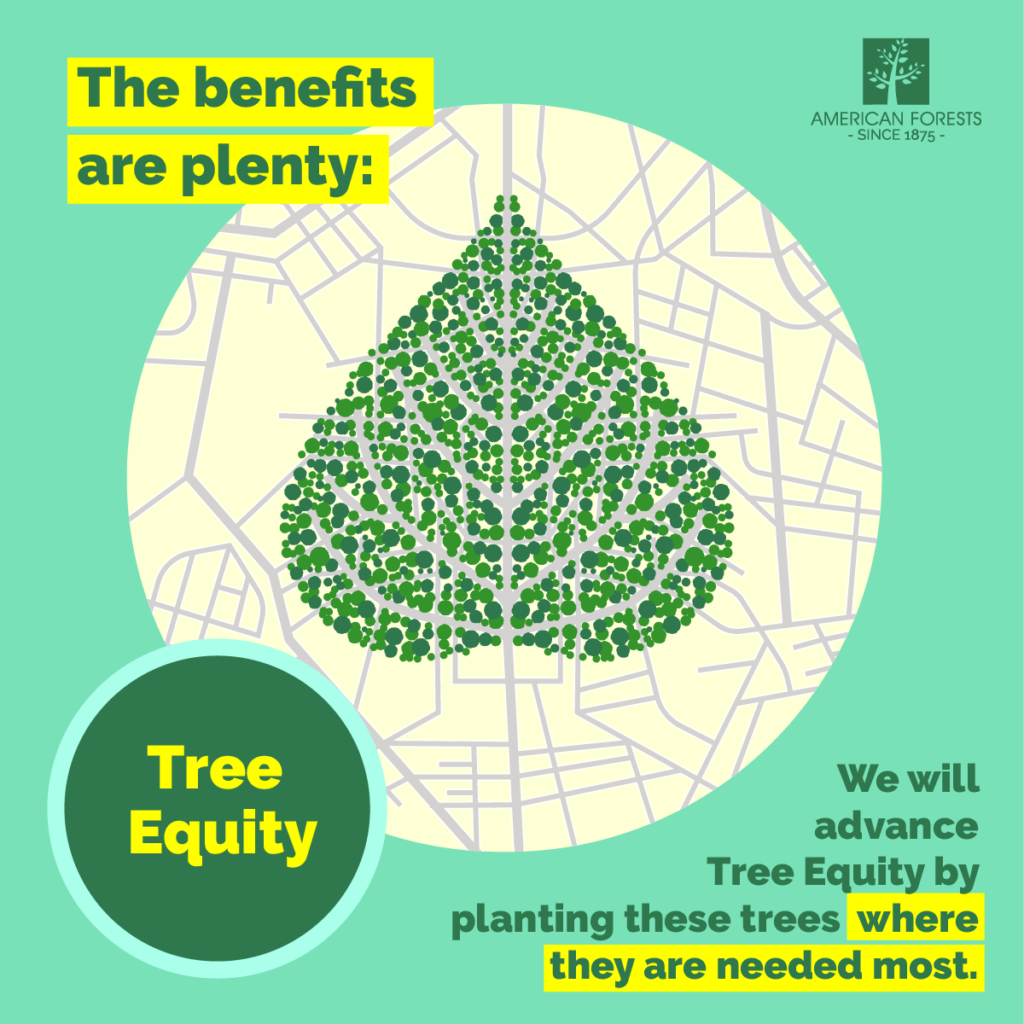Last updated on February 14th, 2024

Trees provide numerous benefits in cities, storing carbon, reducing temperatures, improving air and water quality, mitigating stormwater runoff, encouraging outdoor recreation, and improving human health and well-being. In the United States, urban forests provide estimated annual benefits of about $18.3 billion in air pollution reduction, carbon sequestration, and lowered building energy use and power plant emissions.
Urban trees are responsible for nearly one-fifth of America’s captured and stored carbon emissions. In addition to providing critical ecosystem services and climate mitigation benefits, urban forestry programs create thousands of good-paying jobs and new opportunities for young people. Career opportunities include urban foresters, arborists, tree trimmers, pruners, pesticide applicators and more.
Despite the many benefits that trees provide, research suggests that tree canopy is unequally distributed in U.S. cities with low-income neighborhoods and communities of color often having less tree cover. The inequitable distribution of urban trees furthers social inequities and has serious implications for the health, wealth and resiliency of people living in cities. Two of U.S. Nature4Climate’s coalition members are tackling the issue of urban tree cover head on, taking slightly different approaches to this work. Taken together, these two studies highlight the important role urban forestry programs can play in slowing climate change, reducing social injustices, creating economic opportunities, and making communities more livable.
The Nature Conservancy – The Urban Tree Cover Disparity in US Urbanized Areas

The Nature Conservancy conducted the first national survey of tree inequality, mapping urban tree canopy and temperature across 5,723 cities and towns in the U.S. The main goal for this study was to analyze tree cover and temperature inequality for the 100 largest urbanized areas in the country, housing 167 million people (nearly 55% of the total US population). The data was developed from high-resolution aerial imagery, summer temperatures, and census demographics. The study focused on tree cover inequality relative to income and race.
The research shows that inequality in tree cover between low- and high-income neighborhoods is widespread in the United States, occurring in 92% of the urban areas studied. On average, there was 15.2% more tree cover in high-income areas than in low-income areas. The average surface temperature differential was roughly 3⁰F, but in more than a dozen cities the differential exceeded 5⁰F. Patterns regarding race were similar, with neighborhoods of predominately people of color having lower tree cover and higher surface temperature in most U.S. cities.
The greatest tree inequality was found in the Northeast of the United States, where low-income neighborhoods in some urbanized areas have 30% less tree cover and are7⁰F hotter compared to high-income neighborhoods. Even after controlling for population density and built-up intensity, the link between income, race, and tree cover was significant. Cities with greater income inequality had greater differences in tree cover between high- and low-income blocks. Another important variable in explaining variation in tree cover was population density, with urban areas with higher median population density, such as New York City and Philadelphia having lower tree cover, presumably because there is simply less area to fit trees into more densely developed areas.
The Nature Conservancy found greater disparity in tree cover in the suburbs in low density areas compared to the urban core. Greater inequality in tree cover in suburban areas could be due to the relatively greater importance of actions on private land. It may be that low-income households are less able to afford the cost of planting and maintaining trees. Additionally, low-income households are more likely to be in rental units and are thus less involved in making decisions about land management, while owners are primarily interested in reducing maintenance costs and thus may have less of an incentive to plant and maintain trees. This finding has important policy implications since currently most of the funding and resources for urban forestry programs are directed to major metropolitan areas. Increasing tree planting and maintenance in suburbs could more effectively address tree cover disparities since there is less pavement and density allowing for more room to plant trees.
Overall, The Nature Conservancy’s findings illustrate that inequality in tree cover is widespread and pervasive in American cities and deserves policy attention. Tree planting will need to occur through public sector investment and maintenance on publicly owned land. Increased investment could be more strategically applied if government agencies responsible for urban forestry actively partnered with public health agencies to maximize benefits for both people and nature.
Additionally, tree planting needs to occur on private land and incentives and regulations must be enacted to motivate the private sector to engage in tree planting. The good news is that several programs like this already exist, such as tree protection ordinances, green area ratios in planning codes, and incentives for tree planting from electric utilities. In addition to establishing new trees, it will be critically important to maintain and care for existing trees, particularly mature trees that provide ecosystem services and benefits to communities.
American Forests – Urban Trees Help Slow Climate Change and Advance Tree Equity

When thinking about how to advance Tree Equity and mitigate climate change, it is important to consider projected changes to urban tree cover. The fact is, we are losing tree canopy in cities. And it’s not a problem that is going away. American Forests’ new report on Climate Change and Urban Forests found that in U.S. urban areas, we are losing one tree for every two trees planted or naturally regenerated. There are several factors that contribute to tree loss including, natural disasters (e.g., hurricanes, tornadoes, fires, insects, and diseases), urban expansion and development, improper planting practices and attrition. American Forests projects that 8.3% of existing tree canopy will be lost by 2060.
American Forests looked at county-level data nationwide across different scenarios for both existing urbanized areas and the projected expansion of these areas by 2060 to determine what it would take to achieve to increase tree canopy by 10 percent. To sustain urban tree cover through 2060, they found that about 25 million trees would need to be planted annually. On average, this planting equates to a national rate of one new tree annually for every 3 acres of urban land. However, maintaining existing tree canopy will not be enough.
A 10 percent increase in tree cover is needed nationwide to meaningfully advance Tree Equity and address climate change. This will require planting 31.4 million trees every year and an investment of at least $8.9 billion in urban forestry in the U.S. every year. If we are successful, trees would cover 43.3 percent of U.S. urban areas on average. In addition to planting more trees, it is necessary to increase investment in efforts to monitor and take care of existing trees, which are often larger and more established than planted trees. Scaling up urban forestry efforts would also support more than 228,000 jobs and store almost a billion metric tons of carbon – the same impact as removing nearly 200,000 cars from the road each year. And there would be a savings of nearly $1.6 billion a year from things like avoided asthma-related emergency room visits.
American Forest’ research can help guide decisions about how many trees we need to plant in the United States and the required investment to successfully manage our urban forests.
Key Takeaways
We need a multiplicity of voices advocating for urban trees and working to advance science, policy, funding, and collaboration around urban forestry. Studies like those conducted by The Nature Conservancy and American Forests should inspire conversation among environmental organizations, local government and municipalities, policymakers, health advocates and local communities to determine how to best address equity needs in cities and avoid devastating tree loss.
Caity Varian is the Digital Communications Manager for U.S. Nature4Climate.
